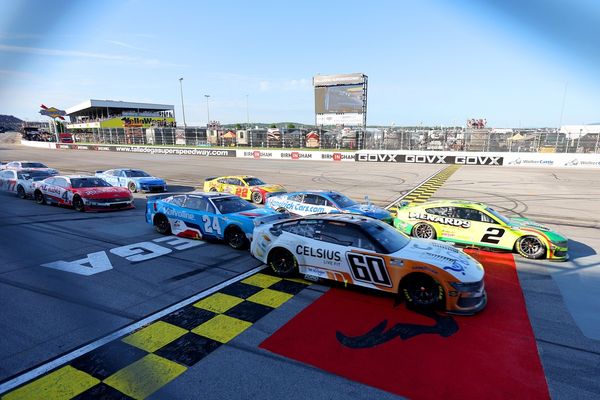
It was impossible to say for sure, since Honda wouldn’t give me a price tag, but I suspected the car I was clambering into was the most expensive I’d ever piloted. In a certain light, it made sense: single seat race car with a carbon-fiber/kevlar monocoque and a theoretical top speed somewhere around 240 miles an hour. In another light, it did not: This car had no wheels.
That is because it was not a car. It was a computer.
I was strapped into Honda Racing’s Driver-In-The-Loop Indycar simulator. This God of all sim rigs features three-axis motion and an actual Dallara DW12 cockpit and wheel for a controller. Half the drivers sitting on the grid in the Indy 500 had been through this exact “car” in the previous weeks, testing different setups, learning every inch of the 2.5-mile superspeedway; Now, I would turn some qualifying laps.

Anatomy Of A Sim
Sim rigs have taken the racing world by storm over the past 15 years, as computer simulation has finally become powerful enough to meaningfully simulate physical, real-world conditions. “Regular”—no driver involved—simulators do this by allowing engineers to tweak settings in a computer model of a car, and then spit out data about how the car will likely react on track. This is often used as a substitute for expensive and time-consuming wind-tunnel testing, for example.
Driver-in-the-loop simulators, such as the one I was strapping into, allow the same kind of pre-race tweaking and testing as traditional sims, except then the driver can actually drive the newly simulated car. This allows for testing to happen weeks in advance of a race without turning a single bolt on a real car (or needing to book scarce track time, or waiting for good weather, or wrecking an $11 million dollar Indycar).
There’s a world of difference between this and a typical racing video game that can run on a console or home PC. In consumer-grade games, everything “real” is heavily simplified to allow the game engine to run fast enough to actually render a playable game across many kinds of hardware. In a driver-in-the-loop simulation, the driving simulator software is custom-tailored for the rig it’ll be run on and the race team that’s using it, and the software emphasizes reality in the aspects that the team is most concerned with. (Honda boasts that this new simulator has vastly more accurate tire modeling than its old rig, and its aero modeling comes directly from Honda’s own wind tunnel research).
The sim also outputs massive amounts of data—1.5 MB per second—so engineers can see how drivers are reacting to tweaks down to the millisecond, and change setups accordingly. Driver-in-the-loop rigs range from wheel-and-pedal setups (not dissimilar to a nicer version of what you might have at home) to warehouse-sized facilities. Honda Racing’s is the latter.
Somewhere Outside Indy
My day began in a nondescript industrial park outside of Indianapolis, where a small sign on the front of an unassuming beige building reads “Honda Racing”. After signing a variety of release forms in the lobby—which could be mistaken for any generic Midwestern accounting firm’s office if not for the trophy case—I stepped through a gray, windowless door. The facade of normalcy vanished: I was in the control room. On this side of a glass divider: a few vending machines, gray particle-board office tables, and a massive array of computers and screens outputting telemetry and driver video feeds, along with two engineers to interpret it all. On the other side of the glass divider: A massive, ten-car-garage-sized room with a carbon Dallara tub perched atop a massive hydraulic mount, surrounded by 270 degrees of screens.
Those screens are run by five synchronized projectors and five individual PCs. Operating in unison, they display a 48K-resolution image that wraps 30 feet around the massive six-foot-tall hydraulic pedestal the Dallara chassis perches upon. The underlying software is a heavily customized version of rFpro, a racing simulator software used by dozens of racing teams across many top-level series. The three-dimensional-motion rig comes from Ansible Motion, a company that exclusively builds simulator installations like this one. (I am told that Ansible only builds eight of these top-shelf rigs per year).
Every other clarifying question I asked about the underlying technology of this engineering marvel was shot down by Honda Racing management. The team was incredibly cagey about the specifics of its simulator, as it is where Honda learns how to make tweaks to its actual, real-world race cars.
Still, every single track in the Indycar calendar is represented in this software, pavement laser-scanned to millimeter accuracy. The lead engineer ran a few very quick laps to show us how it’s done, tackling the Indianapolis Motor Speedway in a simulated qualifying-trim Honda Indycar. He then handed the rig to a fellow journalist, who struggled to get out of the pits, because it turns out an Indycar hand clutch is a hell of a challenge; he finally turned a handful of laps without crashing after a few terribly violent mistakes. It appears driving a car 230 miles an hour is difficult—who knew?
My turn.

Sensory Overload
I walked up the steps in my socks (cowgirl boots aren’t exactly race car footwear), slunk into the retired Indycar monocoque, and the engineer gave me a brief run through. Steering is set to 60% of real force, because 100% force—like that of the real car—and I probably wouldn’t be able to turn the wheel far enough to get through Turn One. There’s a button for radio, hand paddles for clutch beneath the hand paddles for shifting gears, and if I crashed the sim would cut the program, so the wheel’s direct-drive feedback wouldn’t snap my wrists, because it is definitely capable of doing so. Cool.
The cabin slides away from the entry staircase and points nose-first at the wall of projector screens. Indianapolis Motor Speedway appears. Immediately after loading, the cockpit physically shifts to the right and down as the "car" drops off the "jack." It turns out the Ansible rig replicates everything, even tightening the five-point harness under braking to simulate deceleration, which immediately destroyed the knowledge in my head that this wasn’t real. Heart thumping in my ears, I slow-rolled the car out of the pits and basically idled in second gear down the back stretch, trying to remind my body that when I inevitably crashed, I wasn’t going to die, or worse, wreck an $11-million dollar car.
I drove as intently as I could, heart pounding in my skull, but I still kept wrecking every time I’d near a qualifying-eligible pace. Everything just happened too fast. (I swear that despite the fact each of the four corners of the Indianapolis Motor Speedway is identically shaped, something is different about Turn 4—almost every time I wrecked, it was there). Eventually, after crashing enough to remember this wasn’t real, I worked up to a 232-mph-ish pace for a few laps—and then I of course got into a slide.
I have never realized how much I depend on my ass to be a sensory organ while driving. I could feel the rear of the car going long before I’d have been able to catch it with my hands. I corrected it with a snap of my wrists and kept my foot in it. I felt untouchable, but more importantly, I couldn’t believe the fidelity of the simulator. I was able to operate on an instinctual level because my body felt the car slide like it was real, something I’d never felt in any simulation before.
(I wrecked again a lap later, but the point stands.)

Telematics Don’t Lie—I’m Not Very Good
My best lap was close to a slow, but acceptable pace for this year’s 500 qualifying, in the neighborhood of 232 MPH. The engineer showed me a readout of my steering inputs overlaid on Takuma Sato’s, who had run hundreds of laps in the rig in the weeks leading up to the 500. Mine were like a seismograph—jagged corrections dozens of times per turn as I fought to keep the car out of the wall—and Sato’s were smooth curves that looked like they were drawn by a graphing calculator.
If I were good at racing Indycars, this could have told me and the engineers something important, because this tsunami of telemetry is the real reason to build a driver-in-the-loop simulator. Since I’m not, it served as tangible, real-world evidence of how damn hard it is to drive an Indycar fast.







